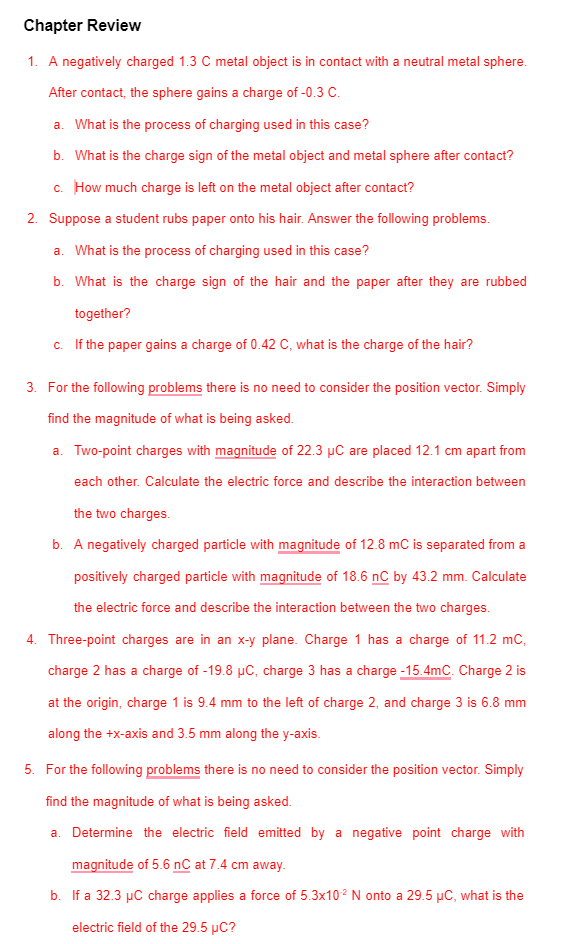1. A negatively charged 1.3 C metal object is in contact with a neutral metal sphere. After contact, the sphere gains a charge of -0.3 C. a. What is the process of charging used in this case? b. What is the charge sign of the metal object and metal sphere after contact? c. How much charge is left on the metal object after contact?
1. A negatively charged 1.3 C metal object is in contact with a neutral metal sphere. After contact, the sphere gains a charge of -0.3 C. a. What is the process of charging used in this case? b. What is the charge sign of the metal object and metal sphere after contact? c. How much charge is left on the metal object after contact?
Delmar's Standard Textbook Of Electricity
7th Edition
ISBN:9781337900348
Author:Stephen L. Herman
Publisher:Stephen L. Herman
Chapter11: Conduction In Liquids And Gases
Section: Chapter Questions
Problem 13RQ: 13. Name two factors that determine the speed an electron attains inside a gas environment.
Related questions
Question
CR1: ANSWER 1

Transcribed Image Text:Chapter Review
1. A negatively charged 1.3 C metal object is in contact with a neutral metal sphere.
After contact, the sphere gains a charge of -0.3 C.
a. What is the process of charging used in this case?
b. What is the charge sign of the metal object and metal sphere after contact?
c. How much charge is left on the metal object after contact?
2. Suppose a student rubs paper onto his hair. Answer the following problems.
a. What is the process of charging used in this case?
b. What is the charge sign of the hair and the paper after they are rubbed
together?
c. If the paper gains a charge of 0.42 C, what is the charge of the hair?
3. For the following problems there is no need to consider the position vector. Simply
find the magnitude of what is being asked.
a. Two-point charges with magnitude of 22.3 µC are placed 12.1 cm apart from
each other. Calculate the electric force and describe the interaction between
the two charges.
b. A negatively charged particle with magnitude of 12.8 mC is separated from a
positively charged particle with magnitude of 18.6 nC by 43.2 mm. Calculate
the electric force and describe the interaction between the two charges.
4. Three-point charges are in an x-y plane. Charge 1 has a charge of 11.2 mC,
charge 2 has a charge of -19.8 µC, charge 3 has a charge -15.4mC. Charge 2 is
at the origin, charge 1 is 9.4 mm to the left of charge 2, and charge 3 is 6.8 mm
along the +x-axis and 3.5 mm along the y-axis.
5. For the following problems there is no need to consider the position vector. Simply
find the magnitude of what is being asked.
a. Determine the electric field emitted by a negative point charge with
magnitude of 5.6 nC at 7.4 cm away.
b. If a 32.3 µC charge applies a force of 5.3x102 N onto a 29.5 µC, what is the
electric field of the 29.5 µC?
Expert Solution
This question has been solved!
Explore an expertly crafted, step-by-step solution for a thorough understanding of key concepts.
Step by step
Solved in 2 steps with 2 images

Knowledge Booster
Learn more about
Need a deep-dive on the concept behind this application? Look no further. Learn more about this topic, electrical-engineering and related others by exploring similar questions and additional content below.Recommended textbooks for you

Delmar's Standard Textbook Of Electricity
Electrical Engineering
ISBN:
9781337900348
Author:
Stephen L. Herman
Publisher:
Cengage Learning

Electricity for Refrigeration, Heating, and Air C…
Mechanical Engineering
ISBN:
9781337399128
Author:
Russell E. Smith
Publisher:
Cengage Learning

Delmar's Standard Textbook Of Electricity
Electrical Engineering
ISBN:
9781337900348
Author:
Stephen L. Herman
Publisher:
Cengage Learning

Electricity for Refrigeration, Heating, and Air C…
Mechanical Engineering
ISBN:
9781337399128
Author:
Russell E. Smith
Publisher:
Cengage Learning